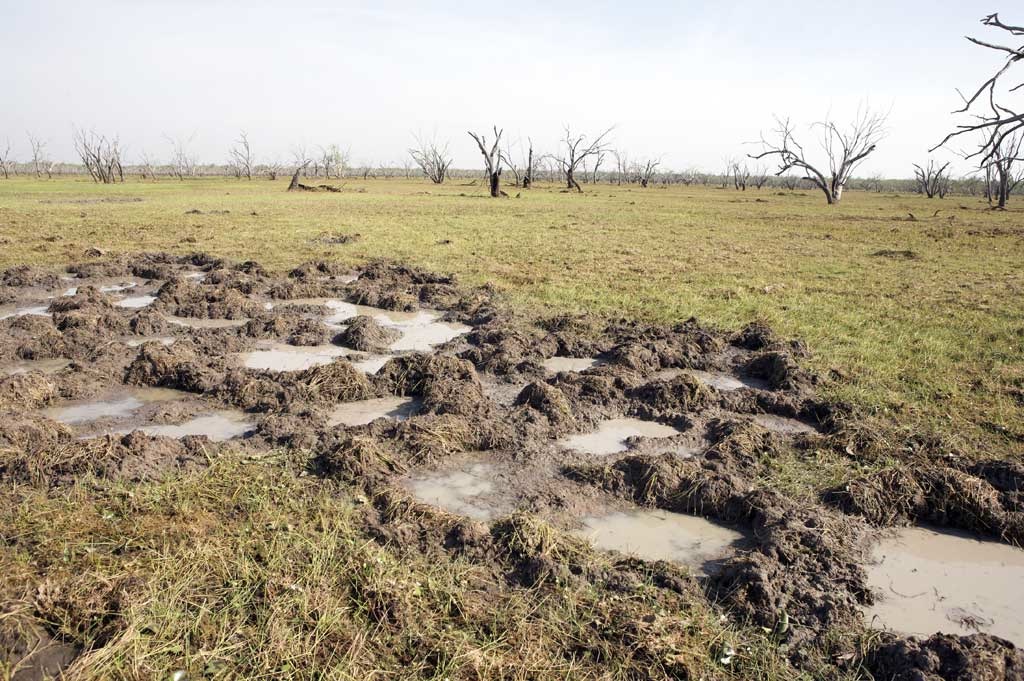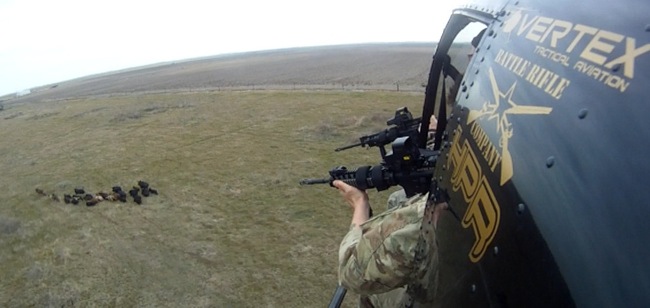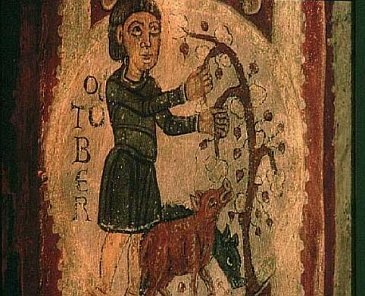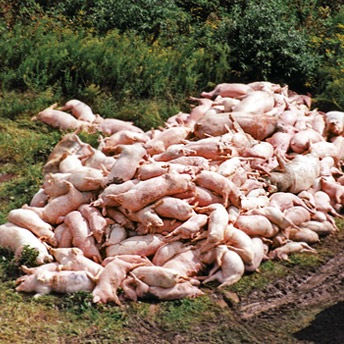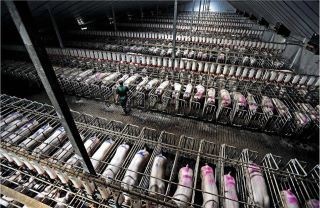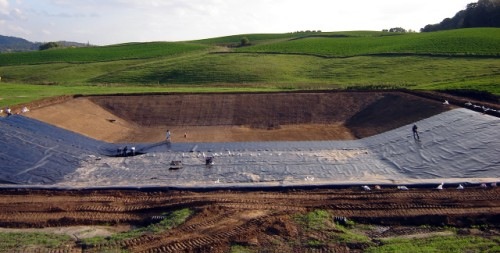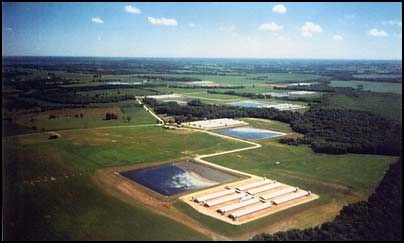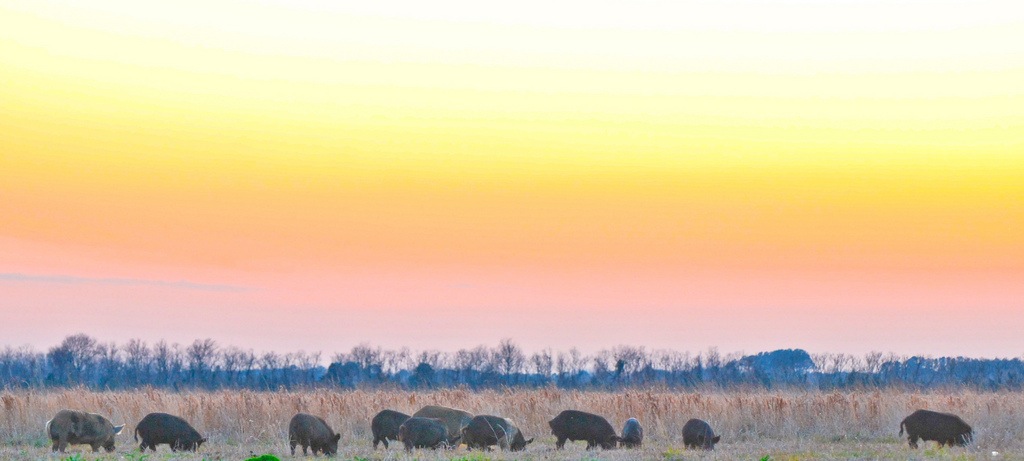The Feral Pig “Problem” - Part 1
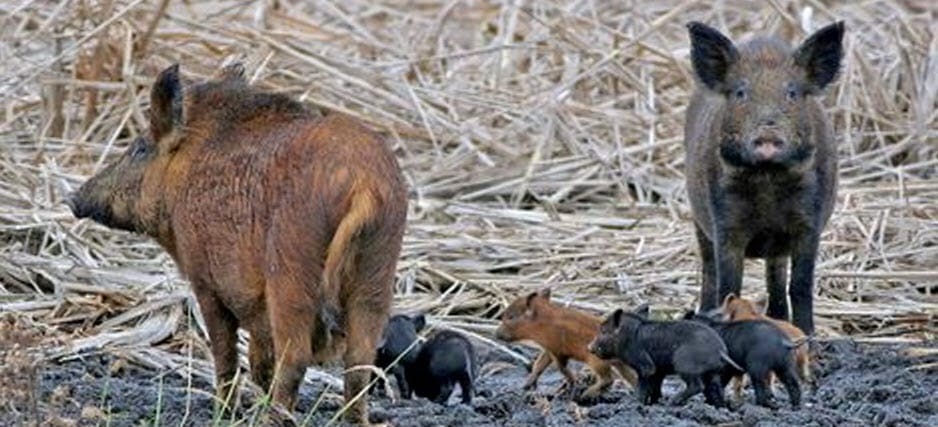
Background
* The Pig “Problem” and “Solution” According to Big Wildlife
* The Root Problem: Hogging the Profits
II: A Brief History of Pigs, Pork and People
III: The Growth of “Efficient” Factory Farms
IV: Meat Factory Pollution and Public Health
V: References and Comments
Author’s Note: Of the many wildlife problems with which we struggle in Texas, feral pigs are one of the most difficult. This five-part series examines this pig “problem.” It asks some common sense questions, offers plain talk about pig-raising ethics, pork safety, and feral pig eradications and suggests solutions that in my opinion are self-evident once the true pig problem is identified.
I regret if these remarks offend friends who, like many, are uncomfortable with criticisms of Big Wildlife and Big Food.
Part I
The Pig “Problem” and “Solution” According to Big Wildlife
As reported by the San Antonio Express News on October 5, 2013: http://www.expressnews.com/news/local/article/Counties-post-raise-bounties-for-feral-hogs-4873123.php?t=d1ebf80996
“There is nothing more destructive that affects more things than drought and hogs,” R.A. “Bubba” Ortiz, a professional hog hunter and trapper, told the American-Statesman.
The hogs also cause environmental damage. “They cause a lot of damage and contamination to water sources,” said Nick Dornak, coordinator with the Plum Creek Watershed Partnership, a group concerned with water quality.
And they are such prolific breeders that their population continues to build by about 20 percent annually, despite hunters taking about 750,000 from the population each year. So if reducing their numbers is an exercise in futility, the best that can be hoped for is to clear areas through maintenance hunts, Ortiz said.
But the beasts are hard to catch. The feral hogs are muscular and tough, capable of running several hundred yards after being shot. They are among this continent’s most intelligent wild animals and appear to have determined how traps work and have warned other hogs, trappers say.
State and federal experts have studied the possibility of poisoning the animals with treated baits, but they have not found the right chemical.
“The thing about using a toxicant, it has to be inexpensive, it has to be a humane, quick death, it has to have little to no impact on nontargets,” including native animals and humans. “That’s pretty dang hard,” said Matt Reidy, a biologist with the Texas Parks and Wildlife Department.
That leaves the emphasis on hunting, and the counties are funding bounty programs from private donations and grants from the Texas Department of Agriculture. Hunters can collect the money by bringing live hogs to a certified hog station or by bringing their tails to designated feed stores.
The Root Problem: Hogging the Profits
Factory hog production is nasty. Thousands of pigs are packed together in giant warehouses where they generate tons of liquid and solid waste, posing health hazards to the surrounding community and degrading the environment. The feces and urine produced in hog factories – containing ammonia, methane, hydrogen sulfide, cyanide, phosphorus, nitrates, heavy metals, antibiotics, and other drugs – fall through slotted floors and into a catchment pit under the pens. Giant exhaust fans pump the toxic fumes out of the warehouse-like buildings 24 hours a day to prevent the hogs from dying. The accumulated waste is then pumped into enormous lagoons that can cover 6 – 7 ½ acres and hold as much as 45 million gallons of waste water. Leaking and flooding lagoons pollute local waterways and the fumes from the waste, which is spread on neighboring fields, choke and sicken the local community.
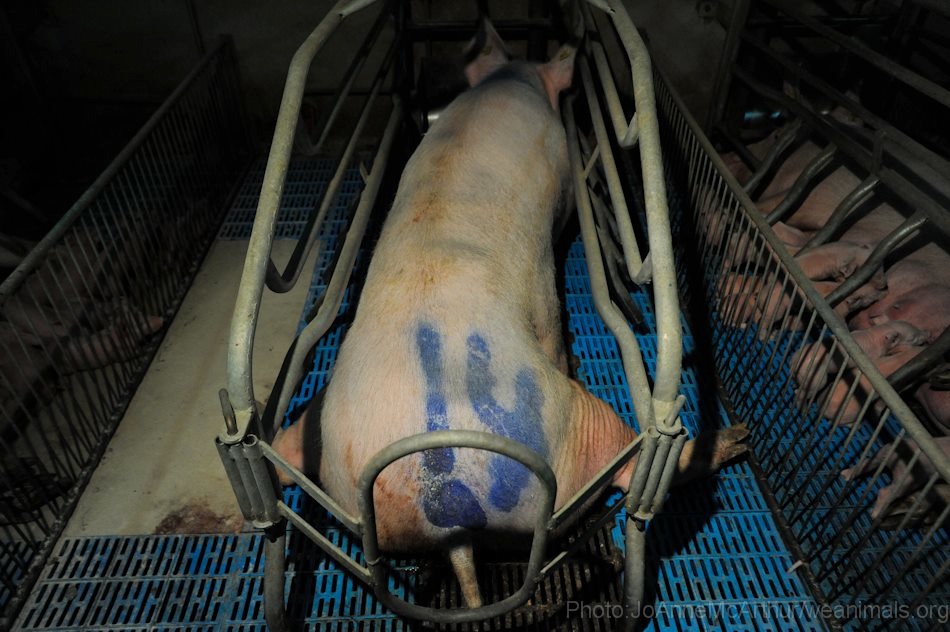
Raising pigs, which are social animals with high cognitive abilities and excellent memories, under these harsh conditions is cruel and inhumane. The life of a factory farmed hog is heartbreaking.
For example, Smithfield’s pigs live by the hundreds of thousands in warehouse-like barns in rows of wall-to-wall pens. Sows are artificially inseminated, and fed, and delivered of their piglets in cages so small the sows cannot turn around. Forty full-grown 250 lb. male hogs often occupy a pen the size of a tiny apartment. They trample each other to death. There is no sunlight, straw, fresh air or earth.
Pigs have not always been raised this way. Pig husbandry is ancient, but even in modern times, one of the unusual factors about the rise of the factory hog farm is that it happened very quickly. In 1992, less than one-third of US hogs were raised on farms with more than 2,000 animals, but by 2004 four out of five hogs came from one of these giant operations, and by 2007, 95 percent were raised under these conditions.
As with most industrialized animal production, the industry has selected certain parts of the country to host hog factories. Iowa, North Carolina, Minnesota, Illinois and Indiana produce two-thirds of the nation’s commercial pork.
The transformation was facilitated by federal policy changes pushed by the pork packers and other agribusinesses. Chief among the factors driving the policy changes was the overproduction of corn, soybeans and other crops used for hog feed that made the feed price artificially low, below the cost it took to raise the crops. When the crop prices to fell below their cost of production many farmers received federal payments to make up the difference, and this actually subsidized the growth of hog factories.
These artificially low prices also encouraged livestock producers to buy feed rather than pasture their livestock or grow their own feed. Since producers no longer needed land for these purposes, it became economically feasible to confine large numbers of animals together in factory farm facilities.
The environmental protection agencies’ disjointed, toothless, and lax oversight of factory farms further enabled hog operations to increase in size.
Weak oversight of waste disposal, the major expense of hog operations, reduces the cost of factory farming and encourages the development of larger and larger operations. Adequate oversight was blocked repeatedly by the livestock industry, which opposed any regulation of these pollutants.
Further facilitating the hog factories’ growth has been the Department of Justice’s failure to prevent the largest meat packers from merging into a virtual monopoly. Beginning in 1980, both parties have acted to unleash this wave of mergers by dismantling the anti-trust laws of Theodore Roosevelt.
Viewed as individual snapshots, transactions appear profitable and in the beginning of the process, most could be justified as exercising the right of owners to sell their company shares to the highest bidder. Yet, when the roll-ups are viewed front-to-back through their serial repetitions (over-and-over, each buyer exits by selling to a larger buyer) the merger and acquisition wave and attendant market profits turned out to have been the cannibalization of America’s working capital and the American job base.
The reason our government has been as useless as “tits on a boar hog” in preventing these perversities is that Big Business and Big Government are two faces of one coin and are interdependent. We cannot manage Big Business through Big Government or vice versa. Those who try only take sides in their internecine struggle.
Speaking as a conservative, who is committed to free markets, competition and affordable government, the idea that these industrial concentrations have advanced, or are leading to free and competitive markets or strengthened industries or an improved society, is ludicrous. We cannot allow our America to degenerate into a business model where monopolies control every industry, or worse, where these merge into foreign-owned, multi-industry transnationals, as is already happening. We already have the anti-trust laws on the books, but we must start enforcing them once again.
The wave of mergers and acquisitions has concentrated the pork-producing sector into the hands of a few powerhouses that employ heavy-handed tactics to minimize the prices they pay for livestock.
As a result, independent hog operators who sell their livestock on open markets have nearly disappeared in the face of massive industry consolidation. The four largest pork processors now slaughter two out of three hogs. Smithfield, owned by the Chinese, is by far the largest. These companies not only slaughter and process the hogs, but they exert tremendous control over farmers through production and marketing contracts. As pork processors have come to increasingly own the hogs they slaughter, the vertical integration and control of the hog sector has pushed prices down and encouraged operators to “get big or get out.”
Subsidized Serfs
The farm tragedy is that the small producer has been driven out of business. The loss of 1.4 million cattle, hog and dairy farms has drained the economic base and vitality from America’s rural communities. We need midsize farmers not only to survive but be viable and form the backbone of American food production.
In 1900, the American farmer received 40 percent of the food dollar. Today, the farmer gets 10 percent.
Most people have no idea that the chicken they eat is raised by a farm family that makes an average of $15,000/year, including all compensation for their backbreaking labor. According to the Contract Poultry Growers Association of the Virginias, of about $27paid to KFC for a 12-piece chicken bucket, the grower who spent six weeks raising the bird gets$ .25.
The consumer price of pork has increased 71 percent between 1985 and today, while the farmer’s share of that price has decreased 49 percent.
USDA statistics greatly exaggerate the number of full time farms and make it look like few farmers get subsidies. Of 2.2 million counted by USDA, one-third have income under $1,000 and two-thirds under $10,000. Actually we have less than one million full-time farms left and virtually all are on subsidies.
Meanwhile, corporate welfare for the giants grows. Of $30 billion in subsidies for programs originally started to keep small farmers on the land, 70 percent, approximately – $22 billion, goes to 10 companies, insuring their advantages over small farmers and accelerating concentrations.
Obviously, this system is economically unsustainable. Yet small farmers and ranchers cling to their handouts, which are small compared to what the big companies get, and fight reform of a system that guarantees their destruction.
The bankrupting of small abattoirs is even worse than that of small farmers and ranchers. Big Meat paperwork and regulations have driven small abattoirs out of business, and yet meat inspection and cleanliness is at a low. We do not have a meat inspection system, instead we have an inspection system of documents created by the slaughterhouses under an “honor system.” Small firms can’t survive these government-imposed regulations whereas bigger firms can. Taxes, mandates, and especially “safety regulations” wipe out competition. We can’t get a deer or cow butchered in most small towns and in many large cities – and this trend is getting worse. Lack of local meat processing facilities forces small producers into the Big Meat system.
Define “Dirty”
Big Meat says feral pigs are dirty. And yet, unbeknownst to consumers, they are eating chicken with external blemishes, tumors, cancers and gaping wounds oozing pus. Meat inspections have been dismantled. Since 1986, no USDA inspectors have been present to see if birds have arrived at the slaughter line alive or if they are already dead from injury or disease. Instead of employing preemptive visual inspections meat is treated with ammonia, chlorine, trisodium phosphate and irradiation at the end of the line.
North Carolina’s 11 million factory hogs create stench, sewage, and sickness, trademarks of the industry. In one animal factory located in the state, 2,500 pigs produced 26 million gallons of liquid waste; 1,000 gallons of sludge and 21,000 gallons of slurry, a thin mixture of water and manure per year. The waste is then sprayed on the nearby culture fields widening the area affected by the toxic chemicals.
These open manure cesspools emit noxious odors into the surrounding communities. The stench has been known to nauseate pilots at 3,000 feet in the air. The odor affects the quality of life for people living in the rural communities near these facilities many of whom can no longer hang out their laundry to dry, sit on their porches or even open their windows. Even worse, residents experience a wide range of health problems including asthma, allergies, eye irritation, and depressed immune function along with digestive disorders and mood disorders such as heightened levels of depression, tension, anger, fatigue and confusion.
North Carolina now has more hogs than people, however, as the hog population has surged the number of farms has plummeted more than 80 percent, as factory farms have driven traditional farms out of business. In 1986, North Carolina had 15,000 hog farms, but by 2007 only 2,800 remained. The state’s hogs produce 14.6 billion gallons of manure every year.
North Carolina’s waters have been polluted repeatedly by waste from hog factory farms, which in some areas stretch as far as the eye can see. In 1985, a lagoon burst and released 25,000 million gallons of manure into the New River; one million gallons were spilled into the Cape Fear River and distributaries in 1995; one million gallons into a tributary of the Trent River in 1996; and 1.9 million gallons into the Persimmon Ranch in 1999. Hog waste was also the likely culprit for massive fish kills in the Neuse River in 2003 when at least three million fish died within a two-month span.
Perhaps the most infamous example of the environmental dangers of hog factories occurred in 1999 when Hurricane Floyd hit North Carolina. The storm flooded 50 lagoons and caused three to burst leading to the release of millions of gallons of manure and the drowning of approximately 30,500 hogs, 2.1 million chickens and 737,000 turkeys.
Smithfield slaughterhouses are no better for the environment than its factory farms. The company plant in Tar Hill, North Carolina is the second largest in the world, slaughtering 34,000 hogs each day. The plant pulls two million gallons of water from the local aquifer daily and returns about 3,000 million gallons of wastewater to the Cape Fear River. Like Smithfield plants elsewhere the facility has been sighted for several environmental violations.
In 1997, the company received one of the largest Clean Water Act fines in U.S. history after officials found that Smithfield and two of its subsidiaries in Virginia failed to install decent pollution equipment and to treat its waste, resulting in 5,000 violations of the company’s permits limits for phosphorus, fecal coliform, and other pollutants. These flowed into the Pagan River, the James River, and the Chesapeake Bay for more than five years. Judge Rebecca Beach Smith stated that Smithfield’s violations “had a significant impact on the environment and the public, and thus in total their violations of the affluent limits were extremely serious.” The company was fined $12.6 million, which amounted to .035 percent of its annual sales.
As bad as Smithfield’s environmental record, its labor practices are also bad, even as an American-owned company. Now, a Chinese transnational, Shuanghui, owns it. The Chinese record for cleanliness, environmental respect and labor treatment is appalling. This culture was the genesis for a now dominant member of the American pig business that is setting prices, wages and standards.
The consolidation trend is accelerating. If it continues unabated for a few more decades, it promises a future in which we have allowed key segments of food production (and of many other industries) to be placed in the hands, not of American-owned monopolies, which would be bad enough, but of foreign, transnational, cross-industry combinations with no allegiance to Americans or our national welfare.
Long before we lose our national autonomy, our workers and farmers will have lost their individual autonomy. In this context, the feral pig “problem” is a mere footnote in the bigger issue of preserving medium size ranches and farms as the backbone of a healthy food production system.

